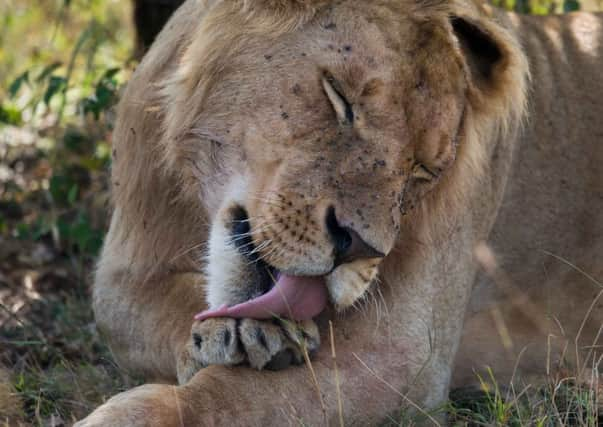Travel review: Kenya


As the lioness wearily raises her head from a parched acacia thicket, safari guide Daniel seizes the opportunity to count the number of whiskers beneath her fleshy-pink nose. He grabs a tatty notebook from the dashboard of our dusty Toyota Land Cruiser and thumbs through pages of childlike lion sketches. After some deliberation, he confidently identifies the lioness as Madala, while behind her rests a male, Naserein.
Daniel pulls out a smartphone to take a picture and record our co-ordinates. A guide for the Sasaab Lodge, he’s one of 20 trained lion watchers operating in the Samburu National Reserve in Northern Kenya, close to the equator, where we’re currently bumping through arid, thorny, sun-scorched plains in search of big cats.
Advertisement
Hide AdAdvertisement
Hide AdArguably the most sought after of safari’s Big Five animals, there are currently 32,000 lions in Africa – a drop of 90 per cent since 1975, according to National Geographic. In Kenya, the birthplace of safari, there are fewer than 2,000 lions, and Kenya Wildlife Service estimates 100 were lost last year.
Although overshadowed by the appalling decimation of elephants and rhino by poaching, the plight of Africa’s lions is now receiving deserved attention. “People expect to see a lion on safari; if they don’t they’d be surprised,” says Mickey Carr-Hartley who, along with his wife Tanya, owns Sasaab and three other properties in The Safari Collection portfolio.
In Samburu, the couple is supporting the work of inspirational conservationist Shivani Bhalla, who is passionately working to raise both the profile and population of Africa’s big cats through her project Ewaso Lions, and guests at Sasaab are invited to learn about her work. She is also responsible for the Lion Watch initiative and the phone app Daniel and his colleagues now use.
Shivani highlights community conflict as the main threat to lions and much of her work involves educating the 600 Samburu families in Westgate about the importance of wildlife.
Advertisement
Hide AdAdvertisement
Hide AdHabitat destruction and overgrazing has led to a significant drop in lions’ prey, meaning many now target the pastoral community’s precious livestock. But by teaching people about the value of wildlife and the money it brings through tourism, along with methods to protect livestock, she has helped raise the number of Samburu lions from 11 in 2007 to a present count of 40.
“And for the first time we’ve noticed that lions in the reserve are starting to roar, a sign they feel safe,” she tells me with relief.
We’re joined by Letoya, a 20-year-old Samburu warrior whose tall, lithe body arches like a bow as he leans in the tent doorway. His sleek, braided hair is pasted with ochre, and he wears a body armour of colourful beadwork.
As part of her Warrior Watch programme, Shivani has trained him and 13 others to become wildlife guardians, monitoring lion behaviour and troubleshooting any problems in the community.
Advertisement
Hide AdAdvertisement
Hide AdIn the past, Letoya, like many of his peers, regarded lions as a nuisance.
“But now I am coming to like them, and I understand they bring me money,” he says with calm conviction. “I want them to be with us for a very long time.”
Shivani recalls an incident last September when Loirish, a lion Letoya was responsible for, was shot in the nearby Kalama Conservancy after killing 10 camels in three months. “Letoya sat next to the dead body for three hours. He couldn’t say a word.”
Guests at Sasaab Lodge can make donations to Ewaso Lions but even by staying in the Westgate Conservancy, where the lodge pays a lease to the Samburu people, they are supporting wildlife and community.
Advertisement
Hide AdAdvertisement
Hide AdThe nine luxurious tents on the banks of the Ewaso Nyiro River are a world apart from Shivani’s simple set-up, but this is far from being a contrived circus show. Almost 40 per cent of children in the conservancy now go to school, and Sasaab regularly donates funds to the Ngutuk Ongiron primary school and clinic. Shivani also works with the Safari Collection’s excellent in-house community and conservation manager Ali Allport on projects to introduce children to wildlife, which they intend to roll out in the company’s Solio property in Laikipia and Sala’s Camp in the Masai Mara.
Set up in 1970, Solio holds the mantle for being Africa’s most successful rhino breeding reserve, set within Kenya’s first private conservancy in a valley between Mount Kenya and the Aberdare Mountains. But I spend my time watching lions. I share an hour with three 18-month-old cubs who tumble and play-flight in the long grass, doing their best to aggravate their remarkably composed father. It’s the first of many sightings.
Nic Elliot, project director for the Mara Lion Project, says in the past five years lions have changed their behaviour and become more shy, after conflict with local Maasai communities. Yet despite all the problems, he still rates Kenya as the best place in Africa to see – and hear – lions.
As I lie in bed that night in Sala’s Camp, in a quiet corner of the Masai Mara Reserve close to the Tanzanian border, I’m certain I hear a gruff, rolling roar. It could be thunder, but I very much hope it’s a lion.
GETTING THERE
Advertisement
Hide AdAdvertisement
Hide AdSarah Marshall was a guest of The Safari Collection (www.thesafaricollection.com) who offer a seven-night package (two nights at Solio Lodge, three nights at Sasaab and two nights at Sala’s Camp) from $5,250 (£3,130, two sharing) on an all-inclusive basis. Includes all transfers, internal flights, park and conservation fees, game drives, sundowners and bush picnics.
Kenya Airways (020 8283 1818, www.kenya-airways.com) fly daily from Heathrow to Nairobi from £732.96 return. The airline also offers connections through KLM’s regional UK departures via Amsterdam to connect with daily services to Nairobi from Amsterdam.